M/T "Stolt Capability"
- the most Complex and Sophisticated
Chemical Parcel Tanker on the Oceans -
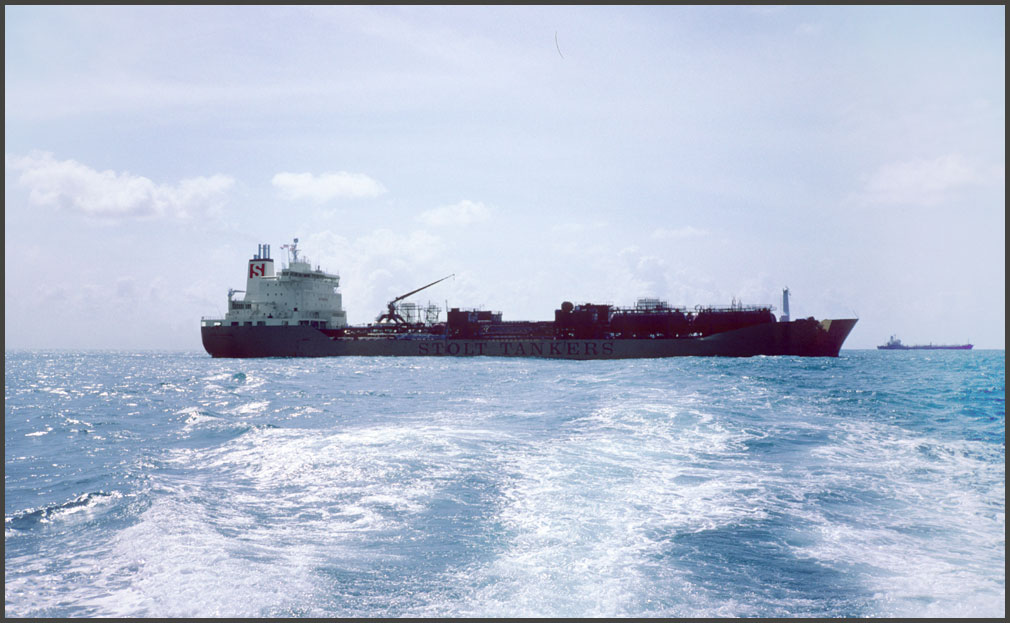
M/T "Stolt Capability"
- at anchor off Panama in 1999
-
(Photography by Karsten Petersen ©)
M/T "Stolt Capability"
- the most Complex and Sophisticated
Chemical Parcel Tanker on the Oceans -

M/T "Stolt Capability"
- at anchor off Panama in 1999
-
(Photography by Karsten Petersen ©)
With the introduction of this ship from the
nineties, we are suddenly in a completely different world compared to the
previous ships in my series of ships on which I have served during the
last 37 years.
The "Stolt Capability" was the 6th. ship
in a series of 7 "Innovation" class chemical parcel tankers delivered in
1998 from Denmark's "Danyard" in the city of Frederikshavn.
If we call the "Samoa" from the fifties for
the "simple ship",- and the "Jutlandia" from the seventies for the "super
ship", then it would be appropriate to call the "Stolt Capability" for
the "smart ship".
Suddenly nothing could be done manually anymore!
Everything is controlled by computers! And you cannot do anything wrong!
If you do, the computers tell you immediately, and block all further attempts
to go on, until the problem is solved.
Fun to compare the alarm points of "Samoa"
with those of "Stolt Capability"! Old "Samoa" from the fifties had
5 alarms,- while "Stolt Capability" from the late nineties has more than
3000! (Cannot remember the exact number!)
What makes this class of ship so totally different
from the previous ships, I have described, is most of all the propulsion
plant.
Instead of the usual arrangement which typically
could be a long stroke, slow speed diesel engine coupled directly to a
propeller, we now see the worlds first diesel-electric propulsion plant
in a chemical tanker!
The huge, traditional 2-stroke diesel engine
was now replaced by 4 medium speed motors each driving a high voltage alternator,
which in turn deliver power for a powerful 10.000 Kw. el- motor in the
bottom of the ship.
The layout of the engine room could therefore
be dramatically changed, so that it now appears with the various engine
room compartments placed on top of each other. This vertical design of
the engine room, makes it possible to squeeze all machinery into a remarkable
short engine room, leaving space for one more cargo section.
The diesel-electric power plant coupled with
a modern Becker rudder and a powerful electric bowtruster, makes the ship
extremely flexible and very manoeuvrable.
On the cargo side the ship is very well equipped
with 42 cargo tanks and 4 deck tanks, - altogether 46 tanks made from solid
stainless steel of a grade that is about 60% stronger than the traditionally
used 316 type -, and it can carry just as many different cargoes simultaneously,
since each tank has its own cargo pump and independent pipe systems.
It can carry virtually any chemical or oil
including those that require special attention, being it heating or cooling.
Heating can be done by steam, hot water or thermal oil,- or a combination
-, and cargoes requiring cooling are cooled by circulating a brine through
a special hydraulically driven cooling unit that can be easily removed
when not required.
Also the ship has its own N2 plant, that
can provide nitrogen blankets of very high purity for filling up the void
space above the cargo surface, so that sensitive cargoes are not contaminated
by exposure to atmospheric air, and at the same time the risk of explosion
of certain cargoes are also avoided, since the N2 blanket makes sure, that
the oxygen level is so low, that the risk of ignition is eliminated.
Of course there is a lot more, - especially
when it comes to automation and control, but it will be too much to mention
it all.
The ship from the early nineties,- the "Stolt
Markland" -, I described as a "happy ship". There are also "unhappy
ships", and unfortunately the "Stolt Capability" belonged to that category
due to leadership problems,- and surprising enough there was no desire
from the responsible people in the office to solve the problem.
Therefore I had to leave this nice ship although
I considered the ship itself near perfect. That statement, - of course
-, is only valid as long as things worked well. However, - when things
did not work as intended, it was more than a nightmare, when the computers
suddenly made themselves "independent" and did "strange" things, which
was not always easy to figure out. Also it was a little bit scary to work
with a voltage 15 times higher than on traditional ships.
But more about the disadvantages later.
For now please have a look at a fantastic,
near perfect ship - - -
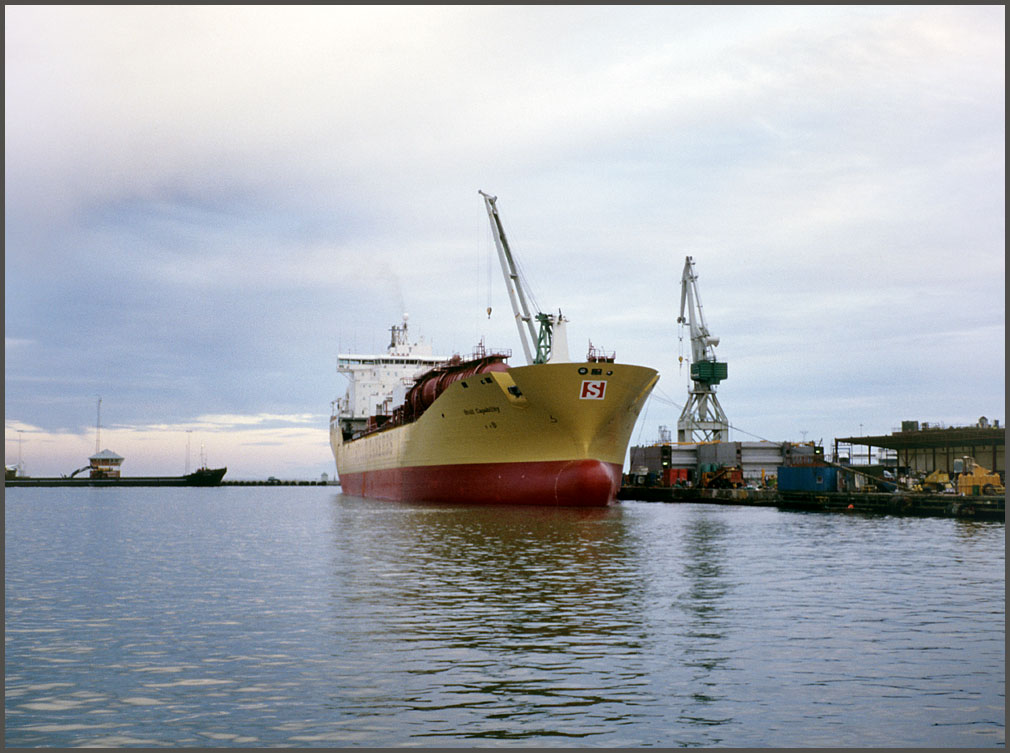
M/T "Stolt Capability"
- the final touch, - being
fitted out at "Danyard", Frederikshavn, Denmark, just before delivery in
1998 -
(Photography by Karsten Petersen ©)
Builders: Danyard A/S, Frederikshavn,
Denmark
Length o. a.: 176,75 meters
Breath: 32,3 meters
Draught: 11,89 meters
DWT: 37042 t.
Propulsion: Diesel-electric
3 pcs. Wartsila medium speed, 9R32E
1 pc. Wartsila medium speed, 6R32E
Power: 10.000 Kw
Speed: 16,5 knots
Owners: Stolt-Nielsen Transportation Group
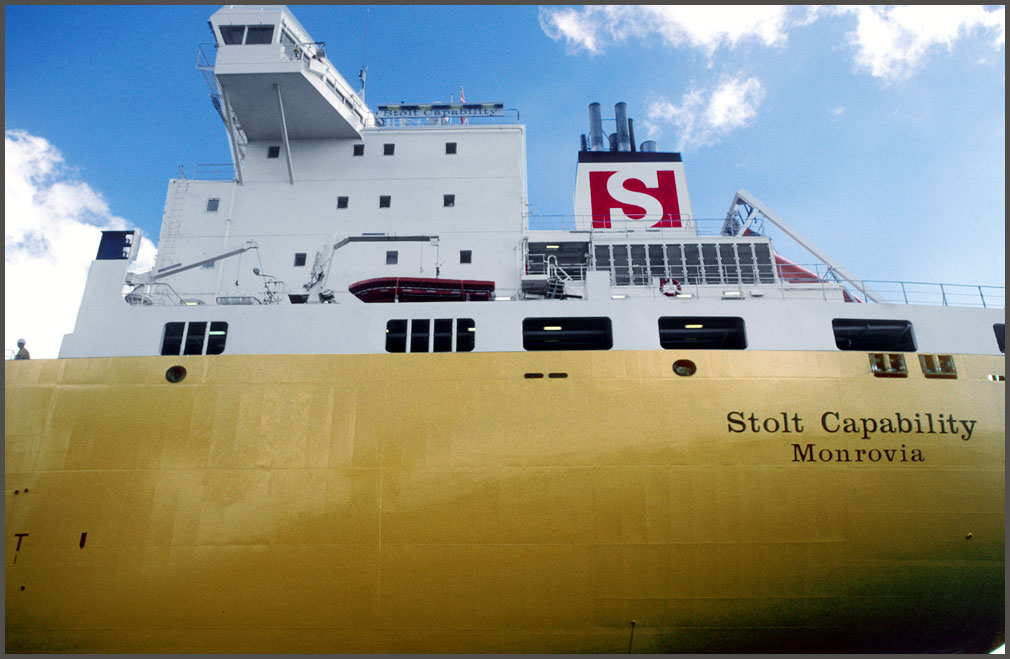
M/T "Stolt Capability"
Here a look at the "hotel"
section just before departure on the maiden voyage -
(Photography by Karsten Petersen ©)
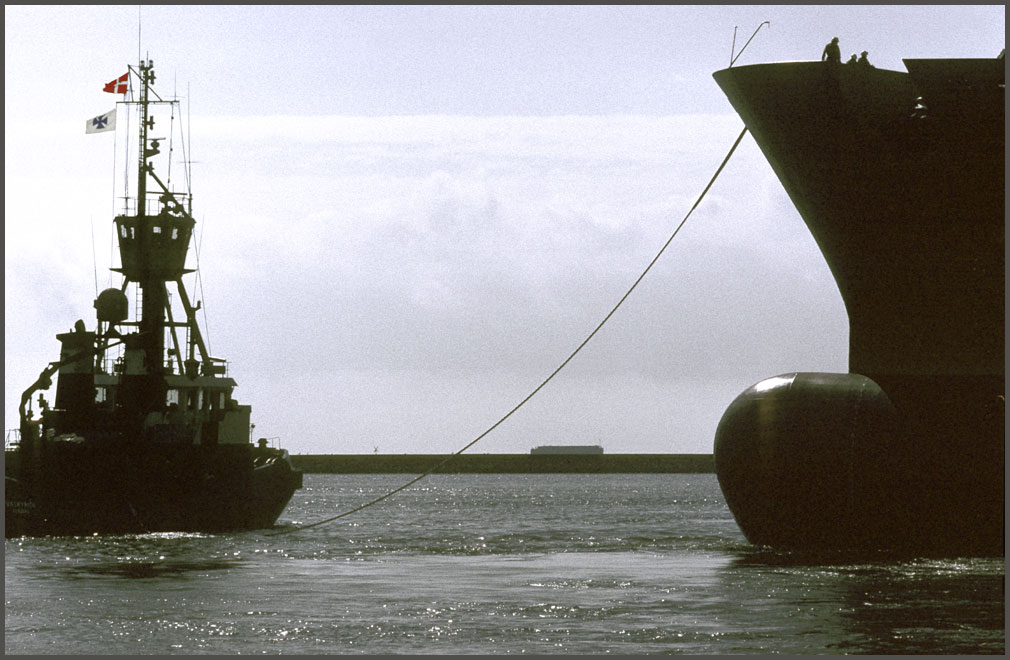
M/T "Stolt Capability"
Departure, - "Stolt Capability"
starts her maiden voyage guided by Switzer tug "Valkyrien".
(Photography by Karsten Petersen ©)
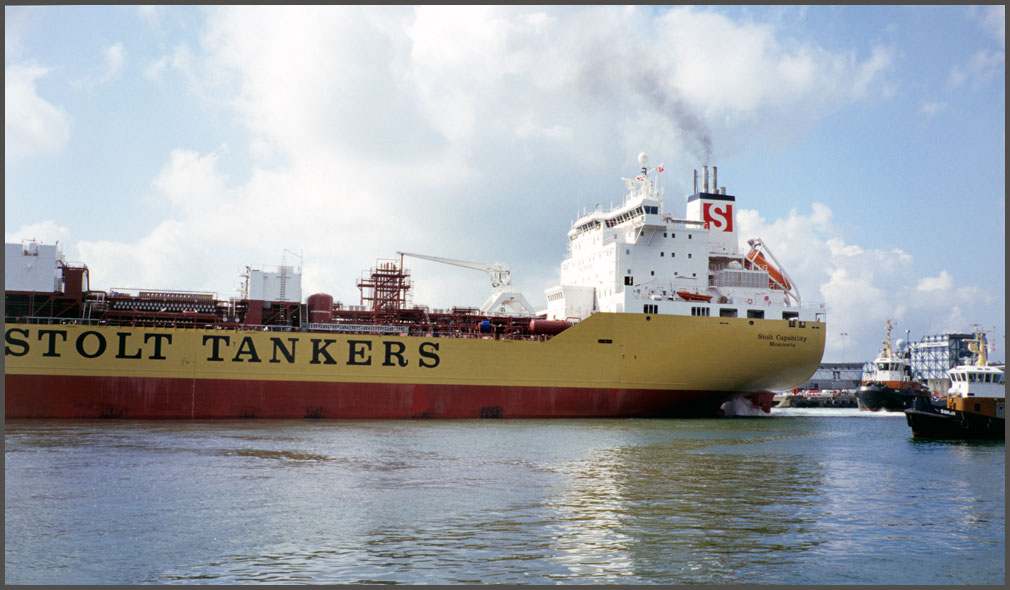
M/T "Stolt Capability"
- propeller turning -
(Photography by Karsten Petersen ©)
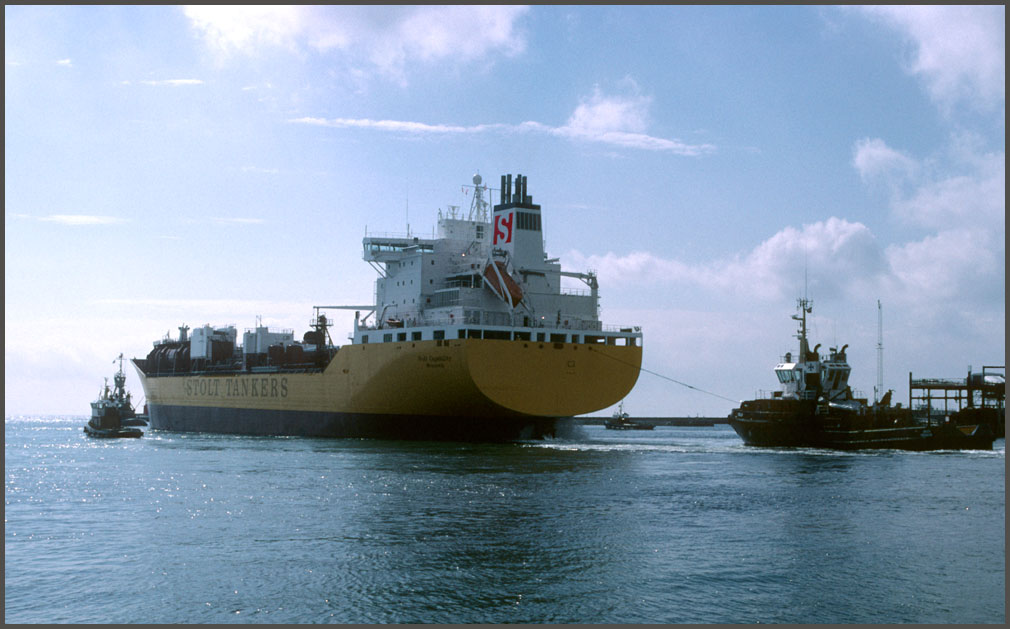
M/T "Stolt Capability"
- on her way -
(Photography by Karsten Petersen ©)
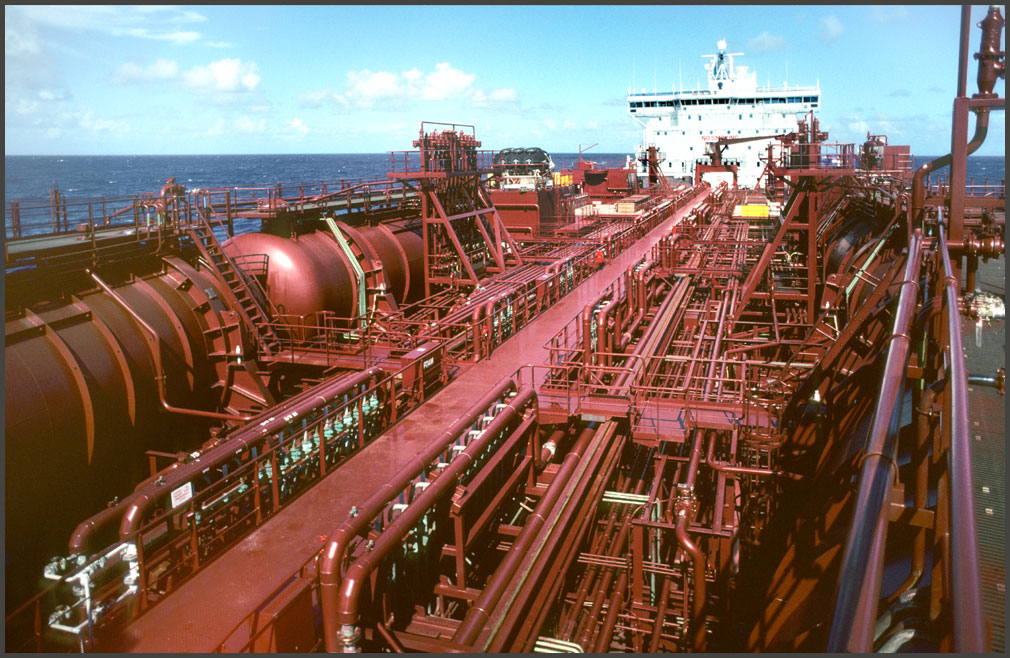
M/T "Stolt Capability"
- a look at the layout
of the deck equipment -
(Photography by Karsten Petersen ©)
It looks more like a complex industrial plant
than a ships deck, but all this equipment is necessary in order for the
ship to carry and handle virtually any type of cargo, as long as it can
be pumped!
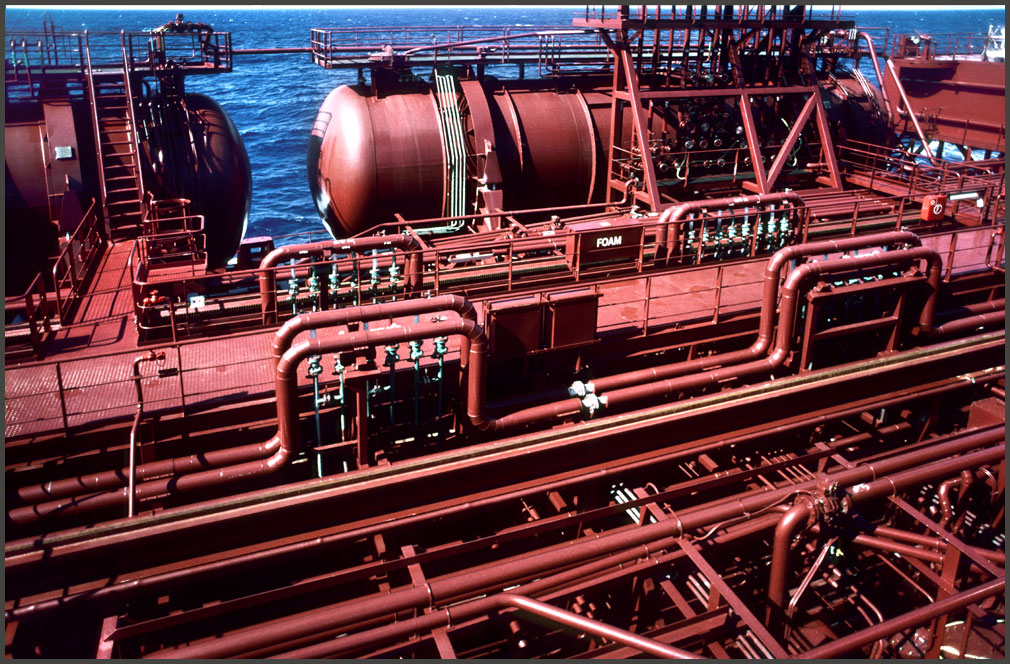
M/T "Stolt Capability"
- a closer look at the
maze of pipes and equipment -.
(Photography by Karsten Petersen ©)
Here you can see some of the about 25 km.
stainless steel pipes on deck. Besides the cargo pipes, there are
also pipe systems for steam, fresh water, hot water, sea water, nitrogen,
thermal oil, fuel oil, brine, fire lines, vent lines, foam for fire extinguishing,
compressed air, hydraulic oil, - plus cables and pipes for sensors, feelers,
gauges and - - - - ???? I might have forgotten something - -
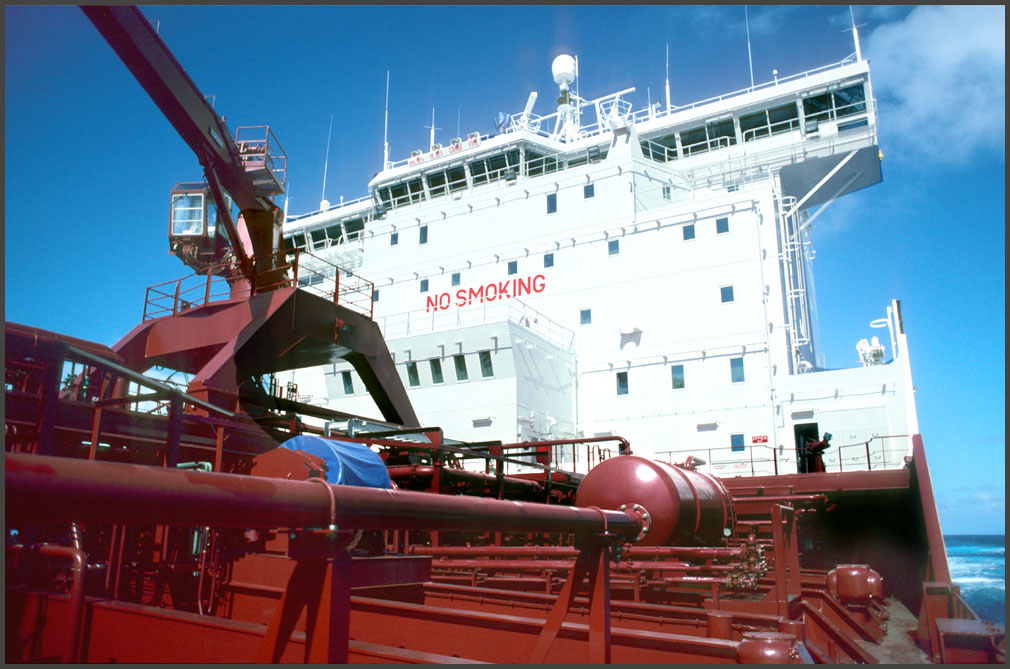
M/T "Stolt Capability"
- view to the bridge
-
(Photography by Karsten Petersen ©)
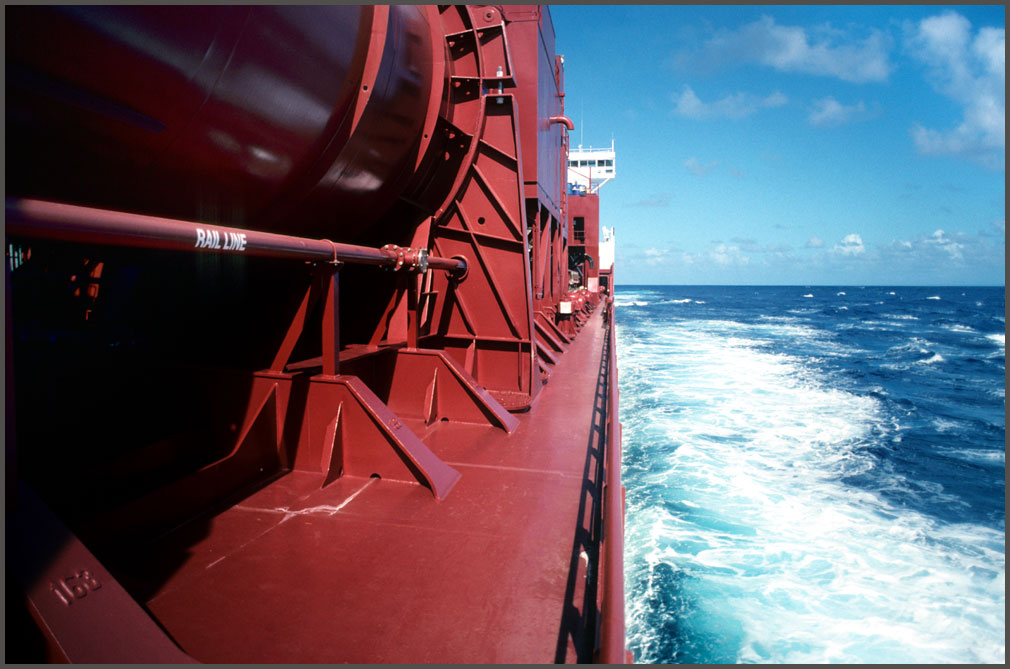
M/T "Stolt Capability"
- the joy of sailing
-
(Photography by Karsten Petersen ©)
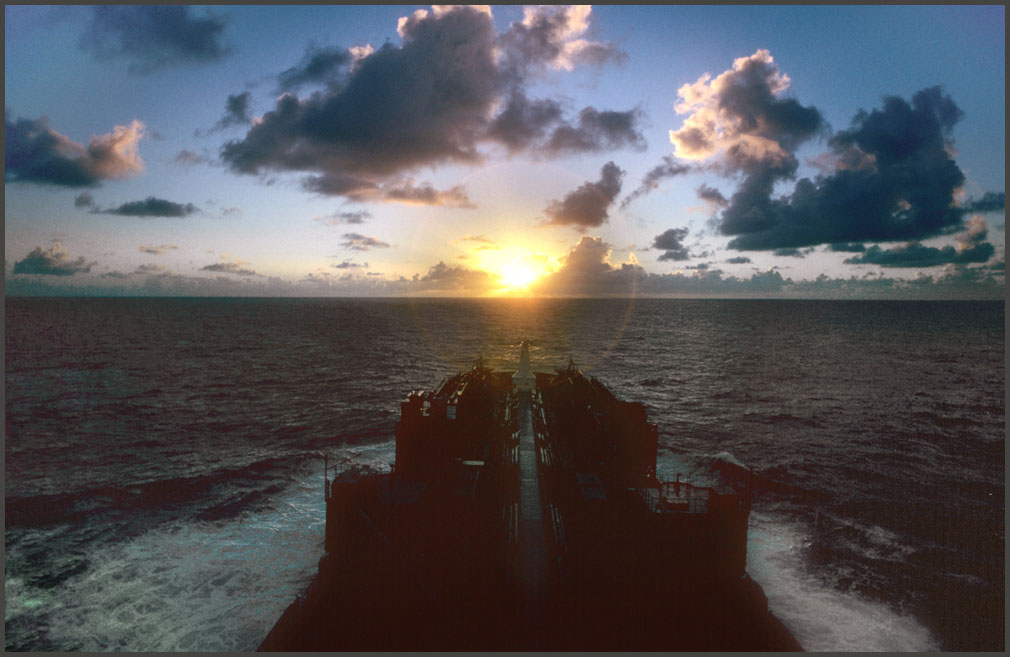
M/T "Stolt Capability"
- directly into the sunset
-
(Photography by Karsten Petersen ©)
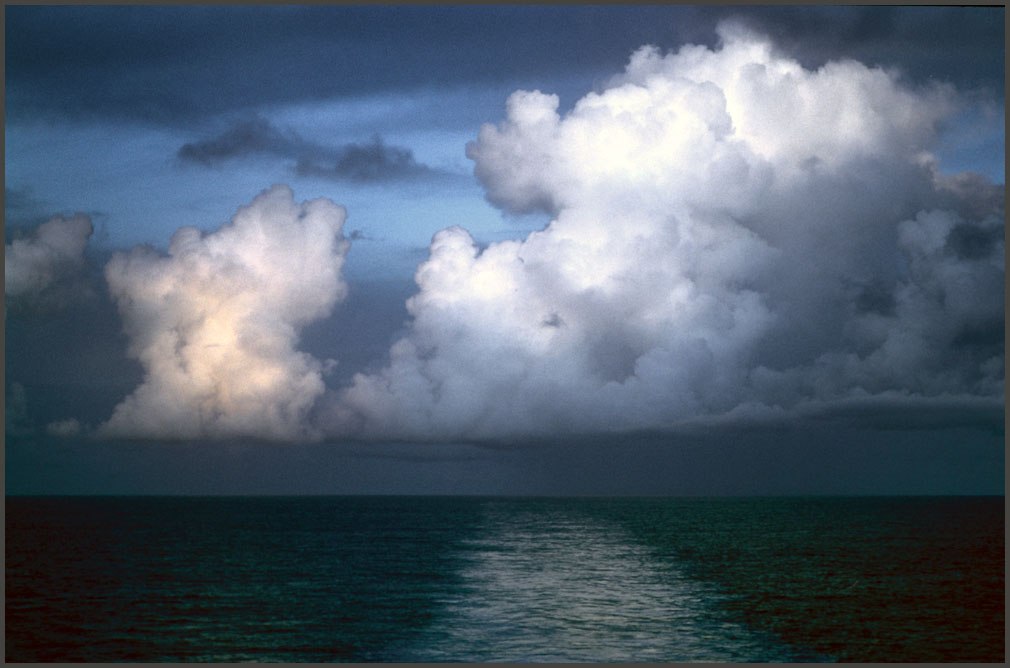
M/T "Stolt Capability"
- leaving a wake from
13.600 BHP behind, - and a fantastic sky -
(Photography by Karsten Petersen ©)
--------------------------------------------------------
The engine room.
Being by far the most interesting thing about
this ship, - I have decided to include many pictures from the engine compartments.
Instead of one huge open engine room with
one big engine, - and all the auxiliary equipment placed on platforms around
it -, the engine compartment on the "Stolt Capability" is divided into
numerous small, closed compartments placed vertically on top of each other.
Yes, - Really! You can here talk about
a "vertical" engine room - - -
The biggest of these compartments is the
main generator room, where the 4 medium speed Wartsila diesels each drive
a high voltage alternator producing 6.600 volts.
Quite a change from normal 440 Volts ship
alternators.
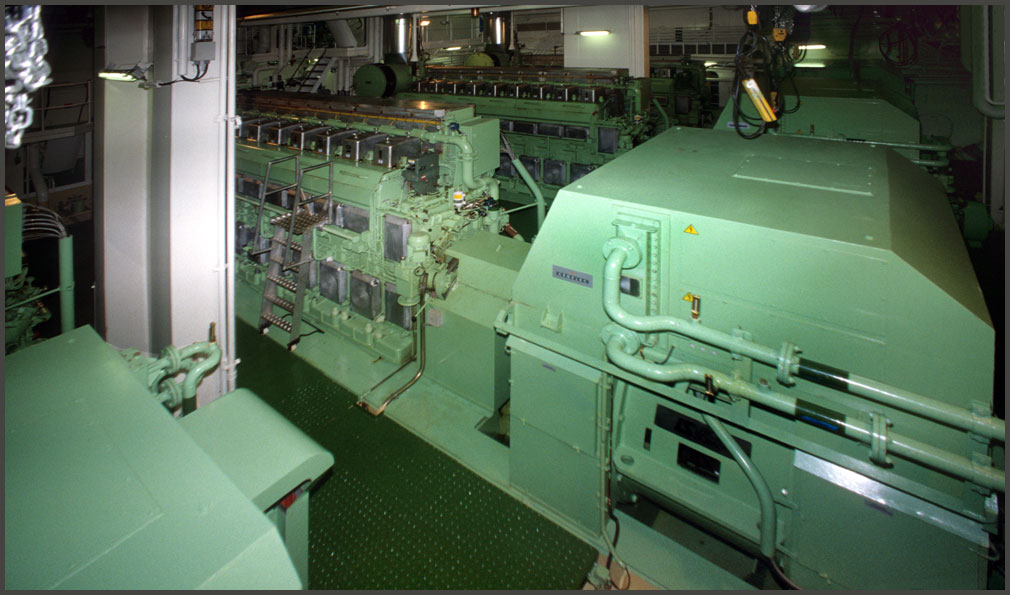
M/T "Stolt Capability"
- The engine room with
four main engines and alternators -
(Photography by Karsten Petersen ©)
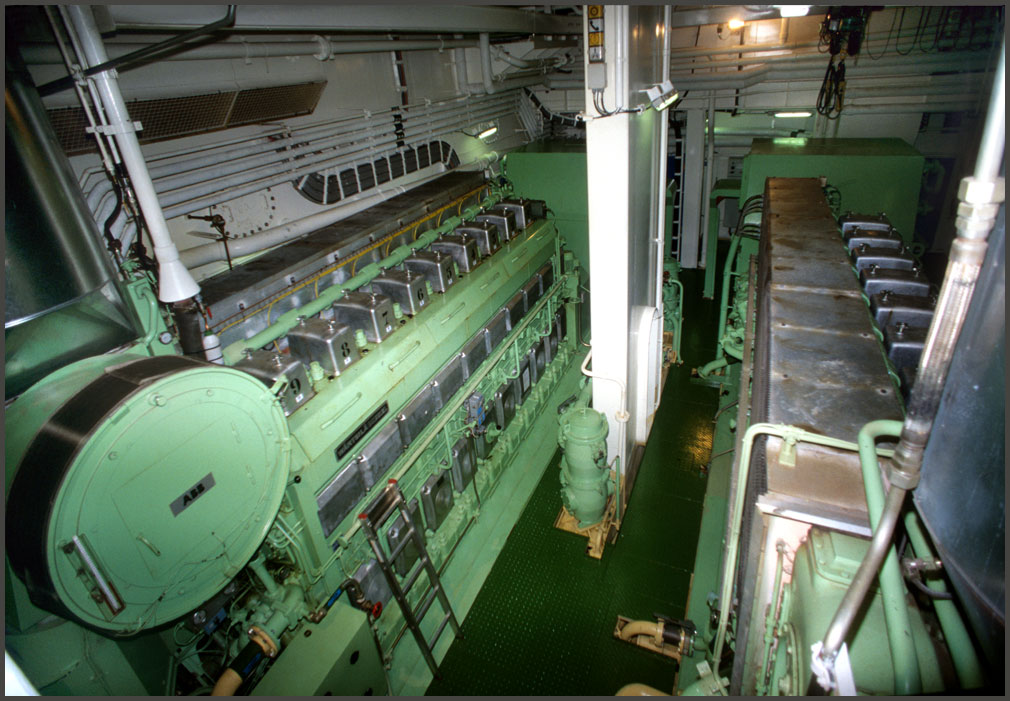
M/T "Stolt Capability"
- another view of the
main engine room -
(Photography by Karsten Petersen ©)

M/T "Stolt Capability"
- a closer look at a
6.600 volt alternator -
(Photography by Karsten Petersen ©)

M/T "Stolt Capability"
Another view from
the main engine room showing two of the four diesel engines.
(Photography by Karsten Petersen ©)
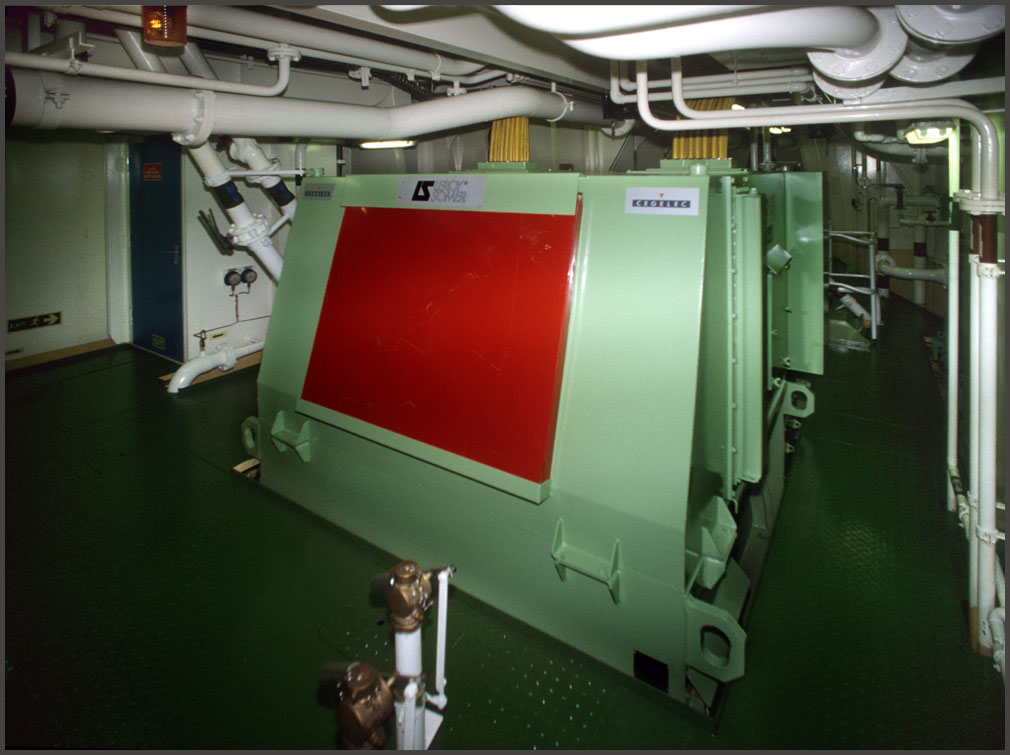
M/T "Stolt Capability"
- deep down below, -
the 10.000 Kw propulsion el-motor that drives the ship -
(Photography by Karsten Petersen ©)
The green square box on this picture shows
the 10.000 Kw el-motor that drives the ship. It is very small for so much
power,- it can easily fit into a normal kitchen -, and it is also interesting
to see that the gear,- the green "thing" in the foreground -, is
actually bigger than the motor itself!
From this gear box, the propeller shaft connects to the propeller.
Although the ships alternators produce 6.600
volts, the el-motor is supplied with "only" 1.500 volts.
The reason is, that on the way from alternator
to el-motor, the voltage is transformed down. Also it has to pass a synchro-converter,
that electronically cuts the original, steady frequency in bits and pieces,
and puts it together again to match the required rpm of the el-motor.
Actually the power transmission goes through
seven steps from generator to propeller. (Generator, alternator, transformer,
synchro-converter, el- motor, gear, propeller.)
This is a lot compared to the only two steps
in the traditional design where the power from the diesel engine goes straight
and directly to the propeller without any intermediate steps.
However, with the diesel-electric system
the control of the engine is very smooth! The propeller can actually run
at only 10 rpm if so desired, and the process of going from ahead to astern
is very smooth and completely step less without having to stop and reverse
the engines, and then starting up again in the opposite direction like
it is done with the traditional design.
It sounds like perfect,- and from an engineers
point of view it is. (Or at least near perfect as mentioned before!)
But there are drawbacks, - especially for
he who has to pay the bills!
As mentioned above, - the diesel-electric
design requires 7 steps from generator to propeller, and each step means
a loss!
The traditional design have two steps,- engine
to propeller-, and consequently the losses are much smaller.
A diesel-electric ship like the "Stolt Capability"
will typically burn more than 60 tons fuel a day, - all included -, while
a traditional design of same power will typically burn less than 40 tons
for propulsion, while the auxiliary engines will typically burn 5 - 6 tons
extra for the remaining consumption.
In addition I am quite sure, that the very
complex diesel-electric design costs considerably more in maintenance than
the much more simple, traditional design.
If you get a short circuit in a normal 440
volts switchboard, you will get a black-out and a possible damage to a
bus bar or to some switch, but you will be able to fix it, and the ship
will continue.
If the same thing happens to a 6.600 volts
switchboard, the whole section melts down completely,- there is nothing
left-, and you cannot fix it!
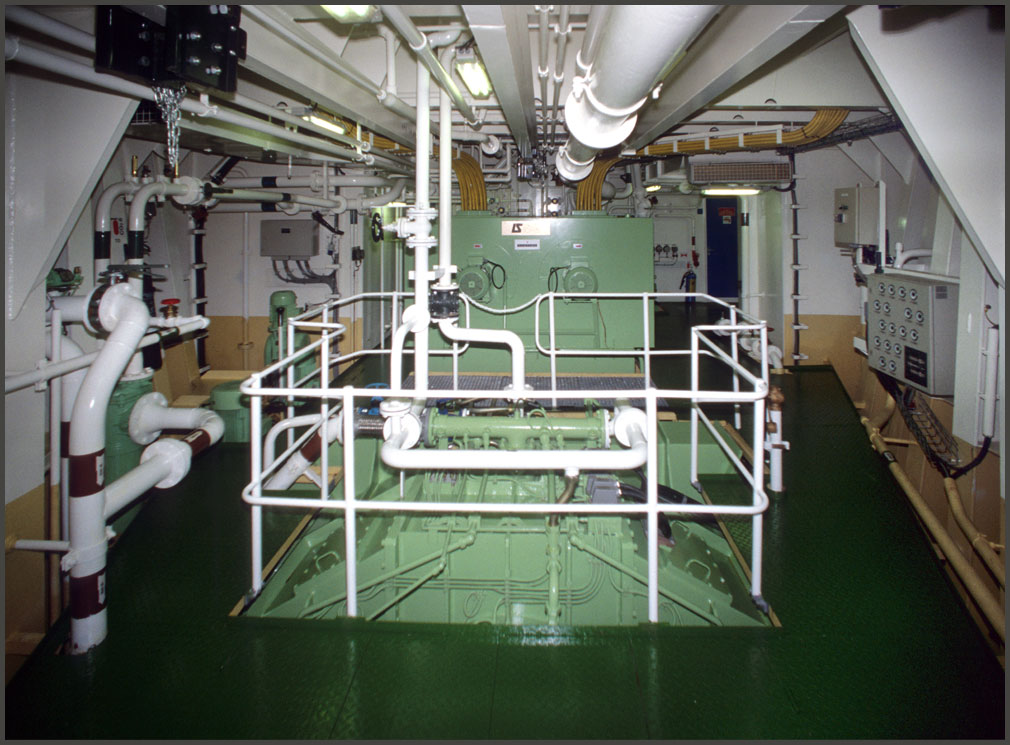
M/T "Stolt Capability"
The propulsion el-motor
behind, - and the reduction gear in front.
(Photography by Karsten Petersen ©)
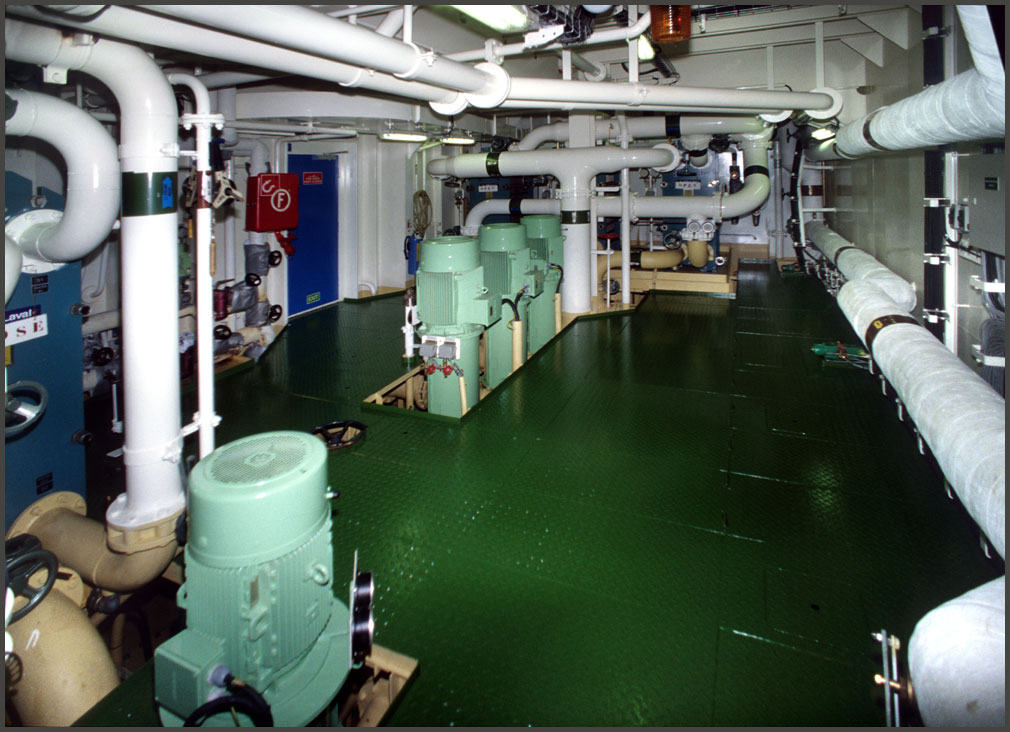
M/T "Stolt Capability"
- the compartment with
sea cooling water pumps and central coolers -
(Photography by Karsten Petersen ©)
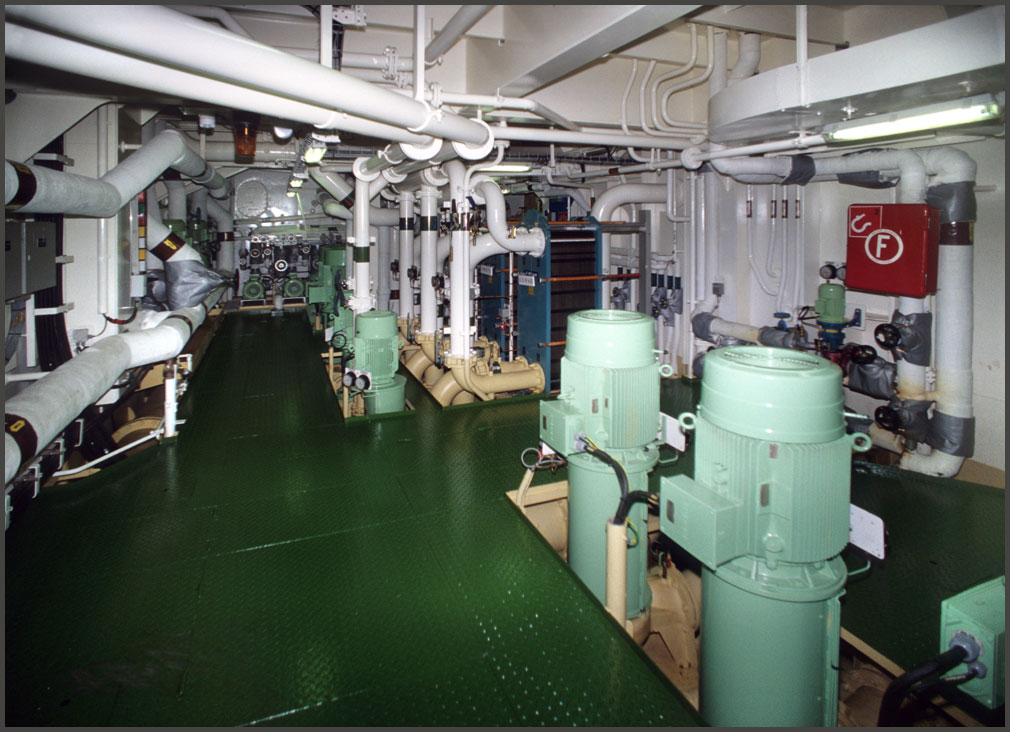
M/T "Stolt Capability"
- the compartment with
sea cooling water pumps and central coolers -
(Photography by Karsten Petersen ©)
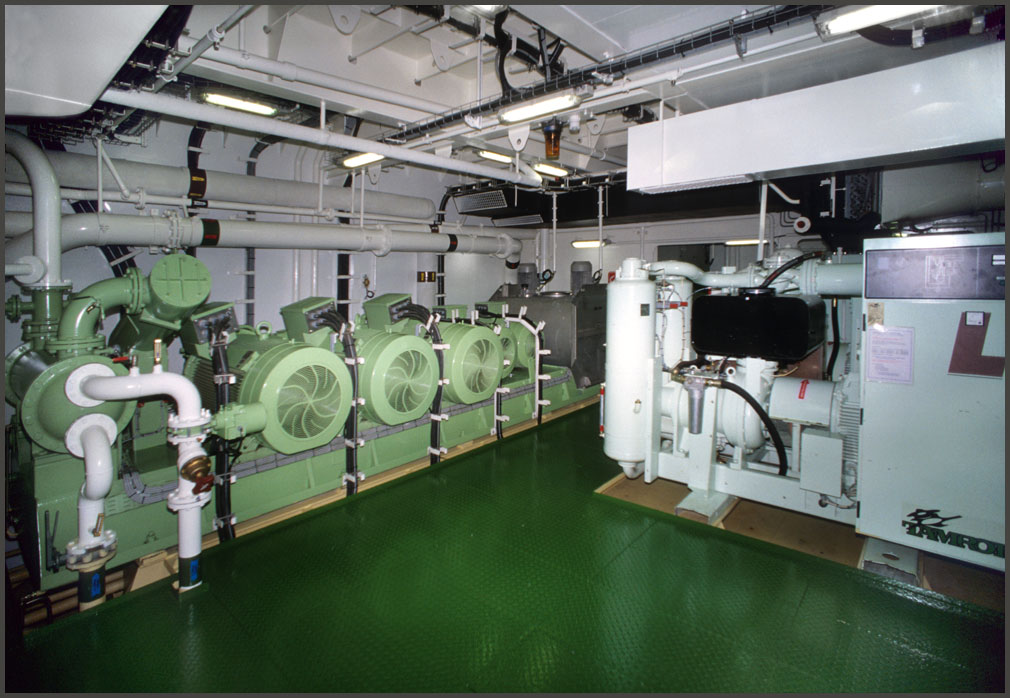
M/T "Stolt Capability"
- and here the compartment
with the hydraulic power packs -
(Photography by Karsten Petersen ©)
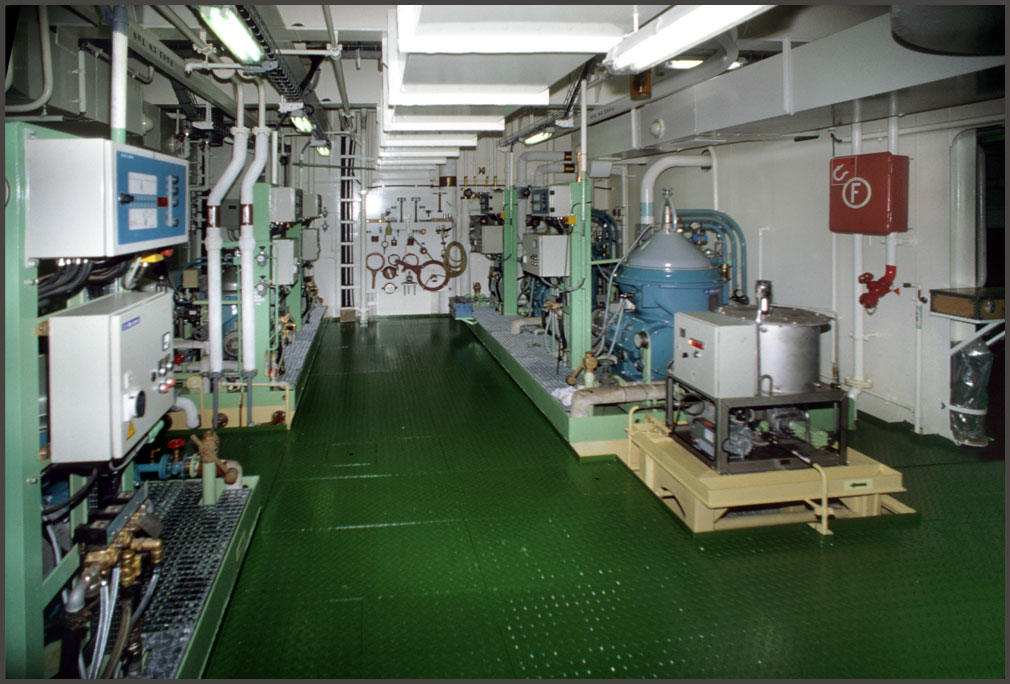
M/T "Stolt Capability"
- the separator room
-
(Photography by Karsten Petersen ©)

M/T "Stolt Capability"
- another view of the
separator room -
(Photography by Karsten Petersen ©)
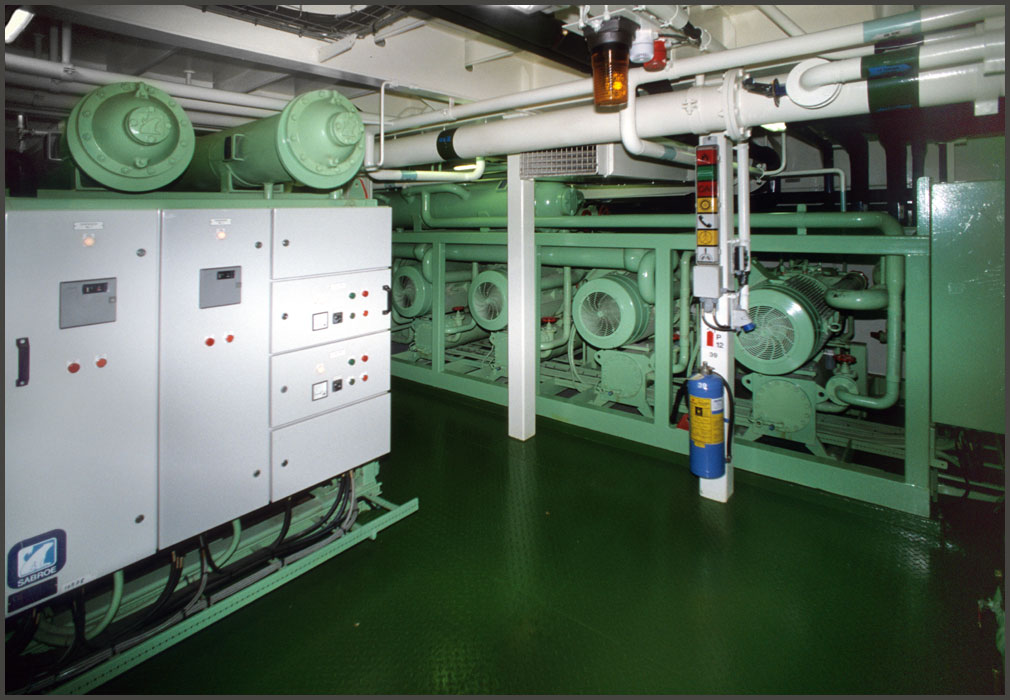
M/T "Stolt Capability"
- the compartment with
refrigeration machinery -
(Photography by Karsten Petersen ©)
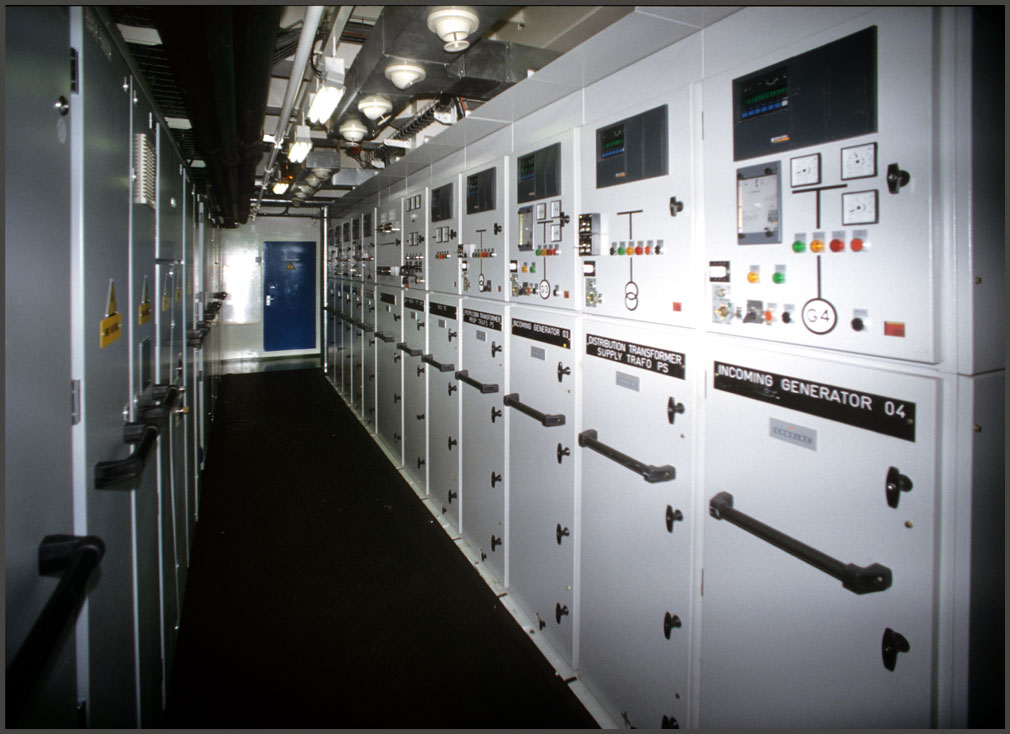
M/T "Stolt Capability"
- the "converter room",
- the compartment with the high voltage switch board -
(Photography by Karsten Petersen ©)
In this compartment the frequency from the
alternators are chopped into bits and pieces, - and then put together again
in accordance to the desired revolutions of the propeller.
The blue door in the background leads into
one of the transformer rooms where the voltage is reduced from 6.600 Volts
to "only" 1.500 volts.
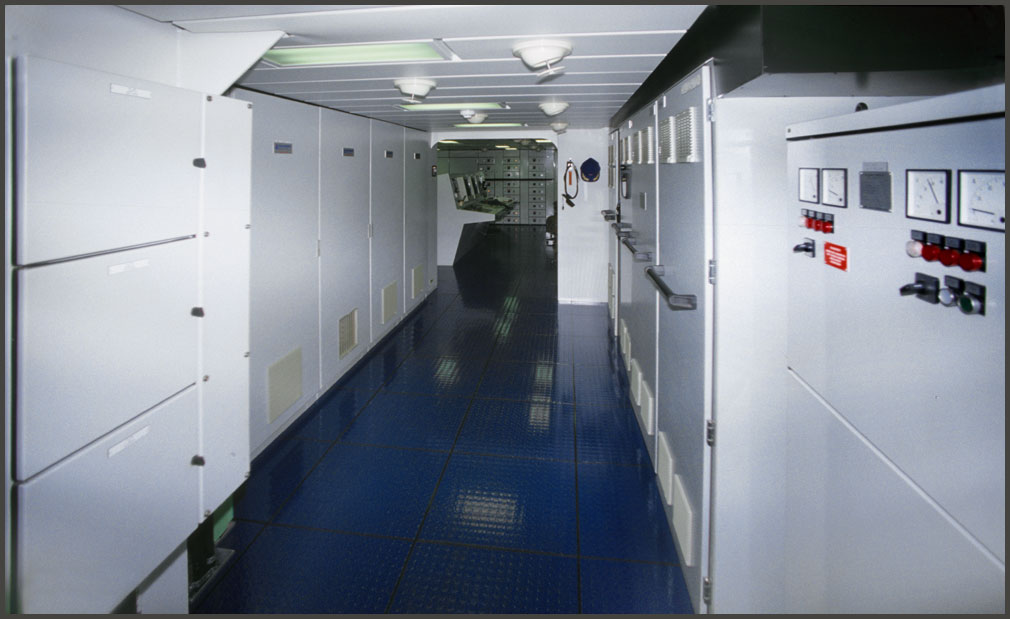
M/T "Stolt Capability"
- here entering the engine
control room -
(Photography by Karsten Petersen ©)
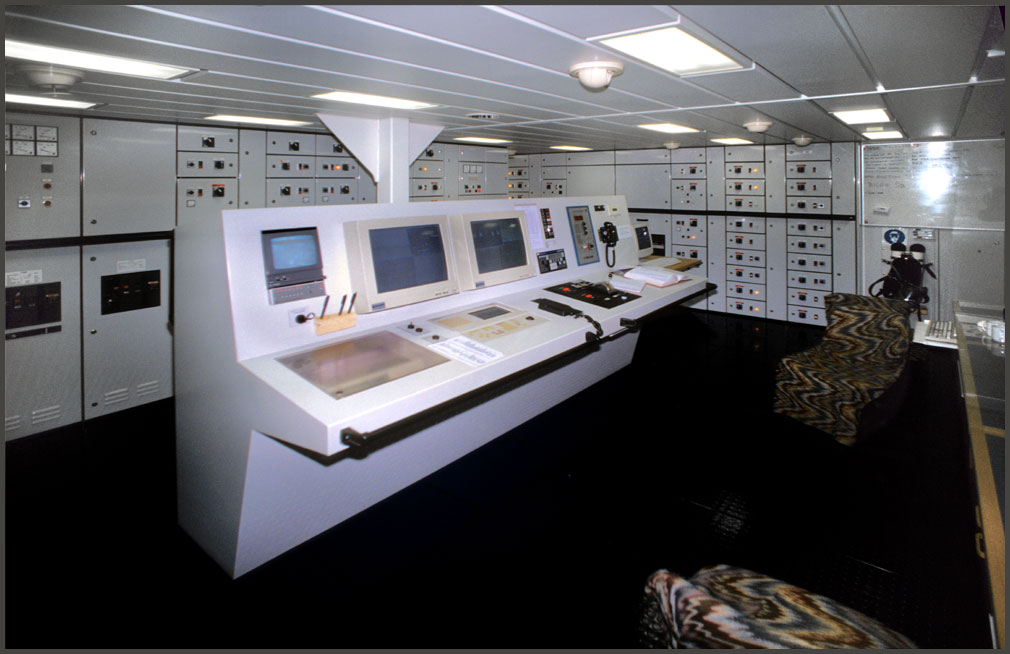
M/T "Stolt Capability"
- the main engine control
console -
(Photography by Karsten Petersen ©)
The engine control room.
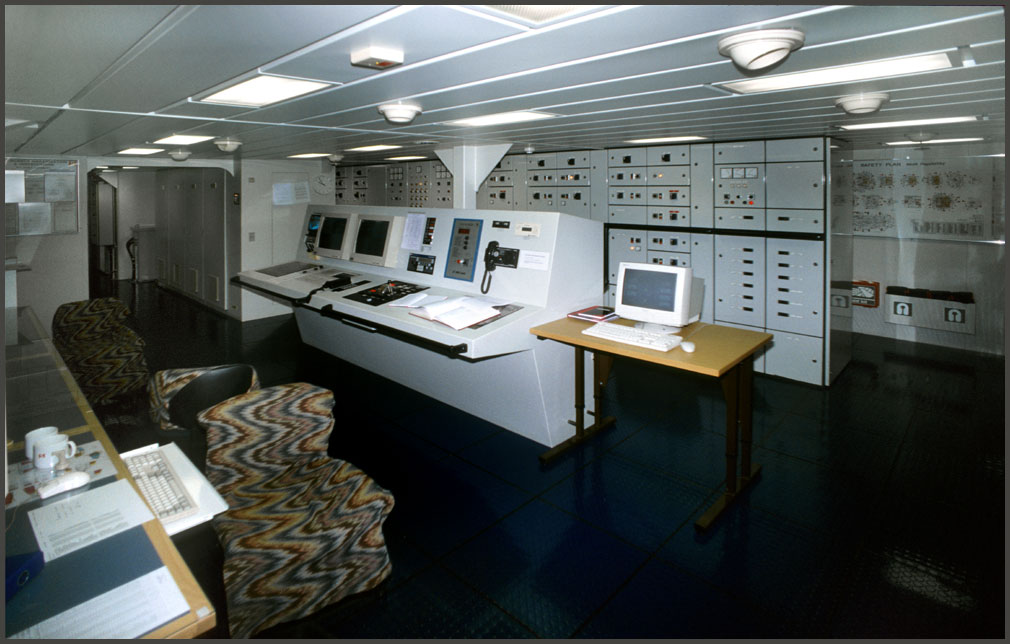
M/T "Stolt Capability"
- another view into the
impressive engine control room -
(Photography by Karsten Petersen ©)
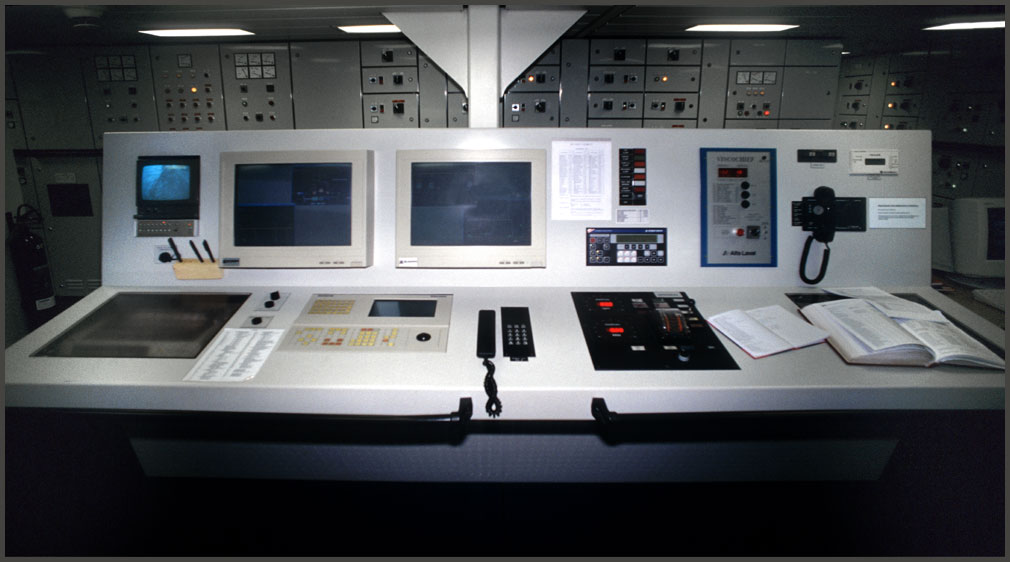
M/T "Stolt Capability"
- a final look the main
engine control console -
(Photography by Karsten Petersen ©)
This quite small and not so impressing looking
desk in the middle of the control room is actually the very brain- and
nerve center of the whole ship.
From here everything is powered, started,
stopped, controlled and constantly monitored, - and without it the ship
would be just a "dead", cold and useless steel construction!
Interesting to think about!
Back to "My Ships"
Back to "The Ships"
Updated: May 14. 2005,
- Nov.09.2008, - Nov.11.2008